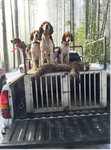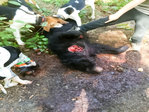

In the mid-1990s, Washington residents worked to put Initiative 665 on the ballot in an effort to limit the scope of what many in the general public considered to be unfair hunting tactics.
When voters ultimately passed the initiative in 1996 and it was signed into law, the use of dogs to hunt bears and other animals, including cougars and bobcats, was outlawed.
More than 20 years later, the use of hound dogs to chase and maul black bears and large cats in the backwoods of Washington has been brought back to the forefront of public attention due to the actions of a seemingly insatiable poaching ring based largely out of Cowlitz County.
The first round of seven suspects in that poaching circle, which has been detailed in The Chronicle dating back to May of this year, are currently awaiting trial in Skamania County where many of the hundreds of alleged poaching incidents are believed to have occured. Using an intricate network of U.S. Forest Service roads, the poachers also illegally harvested animals in Lewis County within the Gifford Pinchot National Forest, as well as Cowlitz County and numerous areas around northwest Oregon. The group’s illegal takes included black bears, numerous bobcats or cougars, deer, elk and one silver gray squirrel. Washington Department of Fish and Wildlife police files indicate that the majority of the poached animals were left behind to waste, with only their trophy parts harvested. Evidence also indicates that numerous packs of hound dogs were deployed by the group and their associates in order to tree target animals while the poachers casually trailed along in their pickups watching the chase live via GPS tracking systems. Once the GPS-collared dogs stopped moving, the poachers would simply walk to the spot indicated on the handheld screen in order to shoot the animal out of a tree.
Sometimes the harried animals would be so exhausted from the chase that they simply sat, defeated and reserved to die at the base of a tree, unable to muster the energy to climb. Text message records sent by the poachers reveal that those “bayed” animals were often considered a disappointment due to their refusal to climb. In any case, the animals were almost always shot anyways, according to records obtained by The Chronicle through public information requests.
On June 1, 2016, one suspected poacher, William “Billy” Haynes, sent a message to another suspected poacher, Joseph Dills, that read in part, “The last 11 out of 12 bears have been bayed. Those f****** don’t want to climb this year.”
In another instance Haynes sent a text message to his mother on Sept. 7, 2015, bragging about how one black bear being chased by a pack of their hound dogs had wound up plunging to its death off of a cliff. That message from Haynes read in part, “...today we struck a huge bear right after daylight ran it for about 4 hours and the GPS said the dogs were bayed up about 800 yards from the road so we walked in and the dogs were all sitting on the edge of about a 300 foot cliff. The bear ran right off it into the river dead as hell. From the size of tracks it was around 350-400 pounds it was a huge bear”
An extensive investigation by the Washington Department of Fish and Wildlife has thus far resulted in charges against seven suspects and hundreds of criminal charges in total, including 79 counts of illegal hunting with dogs. Specifically, charges for illegal use of dogs to hunt bears or bobcats have been assigned to Joseph Dills (26 counts), William Haynes (24 counts) Erik Martin (12 counts), Eddy Dills (10 counts), Bryan Tretiak (four counts), Sierra Dills (two counts) and Aubri McKenna (one count). According to Mike Cenci, deputy chief of westside enforcement operations for the WDFW, additional waves of charges are pending for individuals who have been identified as suspects from an impressive mountain of evidence.
Cenci noted that the use of properly trained hunting dogs can increase a hunters efficiency and success in the woods by leaps and bounds. He says that’s not a problem so long as hunting dogs are deployed in a responsible, and legal, manner, however, when dogs are used outside of the law, they can lead to the mass slaughter of unsuspecting wildlife that hardly stand a fighting chance in the howling face of an unrelenting pursuit.
Cenci says a general lack of familiarity with the hunting dog culture makes it easier for those working outside of the law to go unreported.
“I don’t think a lot of people know what they are looking at a lot of the time,” hypothesized Cenci. “Imagine a guy driving in the woods with a bunch of hound dogs and one up on a box. What does that look like to a common citizen? I mean, I know what it means to me. It’s a dog trying to strike out, but to other people it just looks like a dog on a box and a guy driving slow.”
Cenci added that, “My guess was that in more rural counties like Skamania and Cowlitz, the local folks would understand outdoor pursuits and I think would have some idea of someone operating illegally, but after this I just can’t imagine that people would have seen something and ignored it unless they just didn’t understand what they were seeing.”
Cenci says it is his hope to educate the public about hunting regulations and protocol in order to create what he calls “a better crop of witnesses.”
“I’ll say that of the reporting that we do get, its mostly hunters and fishers. If we didn’t have legitimate hunters and fishers in the field and on our waterways we would be far less successful than we are,” conceded Cenci. “We really depend on the legal sporting public to report what they see when their conscience comes into play.”
Cenci said that he believes the accused poachers were able to get away with their killing spree for so long because of the remote locations of most of their poaching activities as well as their inclination to insulate themselves from the law by associating only with folks who hold a similar nonchalance for what’s right versus what’s wrong.
“Well, as far as the circles they ran in they were all part of that culture,” said Cenci. “I think that they surrounded themselves with people who have the same lack of regard for natural resources and the law.”
Cenci noted that the Dills family in particular was already a well known threat to poach before this case came to light in late 2016. Most notably, Joseph Dills was convicted of poaching in the so called “Kill ‘Em All Boyz” case out of Cowlitz and Wahkiakum counties just over a decade ago.
“As far as the Dills clan, they’ve always been on our radar. We’ve gotten them before and we knew that they were still out and about. But knowing that they were still active and likely to reoffend is different than successfully putting together a case,” lamented Cenci.
Cenci noted an incident from early in September when the WDFW received a report of spotlighting in clearcuts at night. When an officer reported and found two men with archery equipment, they insisted they were simply searching for coyotes, which is legal in the state of Washington, as opposed to deer or elk, which are illegal to spotlight. Cenci says the men wound up being issued a trespassing charge that banishes them from the property for life, but there was insufficient evidence to make any heftier charges stick.
“There’s no doubt in mind that these guys were trying to spotlight an elk and then cover it with a tag in the morning,” said Cenci. “That’s the way things go for us. There’s so many exceptions to the rule that it’s hard for us to do our job in many cases.”
Although legal loopholes such as that one can be frustrating for law enforcement, Cenci says he does not support draconian actions that would infringe upon the rights of upstanding hunters, such as banning the use of hunting dogs altogether in Washington.
“You don’t want to stomp out legal activity due to a small percentage of knuckleheads who might want to take advantage,” said Cenci. “There's no doubt about it that there are guys out there who legally hunt with their hounds.”
The Washington State Hound Council, which promotes the pastime of hunting with dogs, promised to provide a statement for this story but neglected to do so at any point over the past two weeks.
“As careful as everyone was in the journalism community to not represent this as hunting and not besmirch legitimate outdoors people, I think the houndoggers have definitely become a topic of discussions,” said Cenci. “I’m not an advocate of extinguishing opportunity because of a few bad apples. I think the issue here isn't hound dogs and it isn’t spotlights. It’s not enough people to police the outdoors to keep in check folks who are going to violate the law regardless of what laws are contained on the books.”
Cenci says that a succession of budget and staffing cuts in recent years have limited his agency's ability to adequately patrol Washington’s vast backwoods and drainages. He admits that reality eats away at him at night because on a fundamental level he knows that there are poaching activities taking place in one form or another 365 days a year across the state.
“Even if you had a law that said everybody has to stay out of the woods, you would still need officers there to make sure they stayed out of the woods ... There’s always going to be people who push the line and in this case it can be challenging to separate out illegal activity form legal activity, but we’re willing to accept that challenge,” said Cenci. “We need a bigger presence out there to make people think twice … This is not a hound dog issue. This is an issue of poachers feeling like there is no threat of getting caught and running amok.”
Initiative 665 not only banned the use of hound dogs to hunt bears and big felines such as bobcats and cougars. It also protected coyotes and turkeys from harassment by dogs. Additionally, the use of bait to lure in bears was abolished under the initiative.
However, dogs can be legally used to hunt raccoons, except during the months of October and November, which are reserved for hunting seasons for deer and elk. Since dogs are not allowed to pursue injured deer or elk, they must be kept out of the woods during those hunting seasons. Dogs may be used for chasing rabbits or hares without any limitations. Upland bird hunters are also allowed to use birds to retrieve their quarry, but bird dog training is typically allowed only from the beginning of August until the end of March.